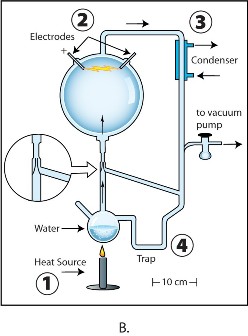
The second experiment was very similar to the first, but used a tapering glass ‘aspirator’ which increased the air flow through the system. This allowed for a more dynamic reaction vessel, or ‘vapour-rich volcanic’ conditions. Miller reported finding five amino acids – aspartic acid, glycine, alpha-amino-butyric acid, and two versions of alanine – in the published experiment. The new study has not only found that the published experiment actually yielded 14, but that the second unpublished version produced 22 different amino acids. In addition, Johnson says, ‘many of these other amino acids have hydroxyl groups attached to them, meaning they’d be more reactive and more likely to create totally new molecules, given enough time’.
The reasons for the second experiment’s higher yield are not clear. Johnson suggests it may be a result of the increased flow rate. ‘Removing newly formed molecules from the spark by increasing flow rate seems crucial’, he explains. ‘It’s possible the jet of steam pushes newly synthesised molecules out of the spark discharge before additional reactions turn them into something less interesting. Another thought is that simply having more water present in the reaction allows a wider variety of reactions to occur’.
Even more difficult to explain is why Miller chose not to publish results from the second experiment. Johnson speculates that he may have been unimpressed with the experiment’s results, preferring to report a simpler procedure in his paper. The third experiment in the series, involving apparatus with an aspirator using a ‘silent’ discharge, seems to have produced a lower diversity of organic molecules.
The revisiting of the Miller-Urey experiments has been of interest to those currently involved in investigating the origins of life, particularly that of past or present extra-terrestrial life. The NASA Astrobiology Institute has supported the investigations and followed the results with interest.
‘This research is both a link to the experimental foundations of astrobiology as well as an exciting result leading toward greater understanding of how life might have arisen on Earth’, says the Institute’s director, Carl Pilcher.